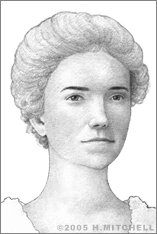Blanche Ames
Blanche Ames’ name is familiar to many for her varied accomplishments as an artist, botanical researcher, and activist. Her truly pioneering spirit and action-oriented attitude also led her to create a number of inventions, adding to her reputation in the early 20th century as somewhat of a “renaissance woman.”
Born into a prominent family in Lowell, Massachusetts, on Feb. 18, 1878, Ames was the daughter of General Adelbert Ames, an American Civil War union officer who would later become Governor of Mississippi, and Blanche Butler, daughter of Benjamin Butler, who was Governor of Massachusetts and ran for President in 1884 against Grover Cleveland. Ames was one of six children.
She earned a bachelor's degree at Smith College in 1899, where she also served as class president. In 1900, she married Oakes Ames (who was unrelated), a botany instructor at Harvard University. The couple had four children before 1910. Meanwhile, Ames, a talented artist, published cartoons in favor of women’s suffrage and, continuing from her college days, was involved with the Massachusetts Suffrage Association. She and her husband built a mansion in North Easton, Massachusetts on land they called Borderland, where she had an art studio. There she painted portraits for prominent people in the area, continued to draw political cartoons for publication, and began illustrating orchids for her husband to accompany his research.
Ames became very well known for her orchid drawings, producing hundreds of them over a 50-year span, mainly related to her husband’s research in orchidology. Together, the Ames created a comprehensive body of research on the Orchidicae class of plants and also developed the Ames Charts, watercolor-illustrated charts showing important plants’ phylogenetic relationships.
A staunch Republican, Ames was a political activist as well, an outspoken feminist who worked hard to achieve women’s right to vote and women’s rights to birth control. She co-founded the Birth Control League of Massachusetts in 1916, a regional chapter affiliated with Margaret Sanger’s national initiative.

Through all of these activities, Ames was an innovator who was constantly thinking up new devices, processes, and policies that she hoped would make the world a better place. This included inventing. During World War II, she invented and patented a method for using strings held by balloons at high altitudes to try and trip up the propellers of enemy planes. The concept was said to have been demonstrated to military officials at Borderland, but it came a bit too late and was never actually used in the war effort.
She also patented a toilet design that she hoped would be better for the environment. She also developed, with her brother, Adelbert, a scientific method for mixing paints to certain color specifications. She created a method for cutting hexagonal shapes in wood. She designed and created plans for many of the dams and ponds surrounding her home at Borderland, and even worked on ways to breed a more disease-resistant turkey.
Ames continued to serve in the public eye throughout her life as well. In 1941, she became a member of the corporation of the New England Hospital for Women and Children. She was named President of the board in 1952 and was successful in securing significant funding for the institution’s growth and expansion.
When she was 80 years old, she wrote the biography of her father, “Adelbert Ames: Broken Oaths and Reconstruction in Mississippi, 1853-1933.” She lived at Borderland until her death in 1969, at the age of 91. Borderland has since been turned into a Massachusetts State Park.


